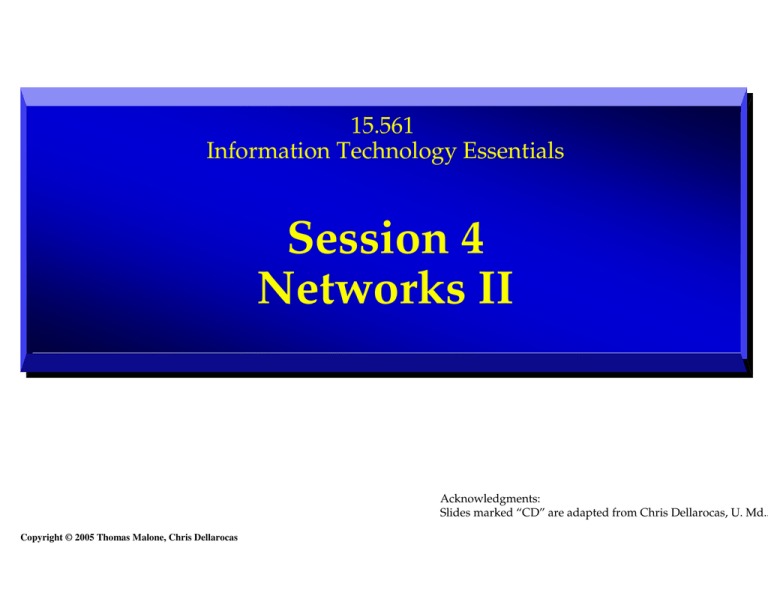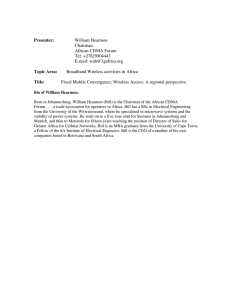Document 13616788
advertisement

15.561 Information Technology Essentials Session 4 Networks II Acknowledgments: Slides marked “CD” are adapted from Chris Dellarocas, U. Md. . Copyright © 2005 Thomas Malone, Chris Dellarocas Outline • Network protocols – Enterprise networking • Example: Looking at a web page • Wireless networks – Wireless telephony – Wireless data communication What does it mean to be on the Internet? • Run TCP/IP protocol • Have an IP address • Have ability to send IP packets to other machines on the Internet CD Network Protocols • Rules of behavior – What, when, and how should A send messages to B and vice versa? • Protocol layers – Each layer uses the layers below it and can be used by the layers above it – Often, multiple alternatives can be substituted at one layer without affecting the other layers Example: TCP/IP protocol architecture Application layer Provides communication between applications on separate machines (e.g., email, file transfer, web browsing) Transport layer Provides end-to-end reliable data transfer across multiple networks (e.g., TCP - Transmission Control Protocol) Internet layer Routes data from source to destination through one or more networks (IP - Internet Protocol) Network access layer Manages logical interface between a machine and its local network (e.g., Ethernet, X.25) Physical Layer Converts bits to signals and back (e.g., wires, radio, etc.) Different types of connection protocols X.25 -- A packet switching protocol for connecting devices on a WAN Frame relay -- Another packet switching protocol for connecting devices on a WAN (faster but less error checking than X.25. Up to about 45 Mbps) Asynchronous Transfer Mode (ATM) -- A “cell switching” protocol that establishes “virtual circuits” from fixed size packets (faster than X.25, e.g., suitable for real-time video. Up to about 622 Mbps) Different types of connection “boxes” Hub - Connects parts of a network, typically different parts of the same LAN (network access level) Bridge -- Connects two LANs using software (network access level) Switch -- Connects different LANs, typically using hardware only (network access level ) Router -- Connects two networks that may or may not be similar and routes packets appropriately (Internet level) Gateway -- Connects networks that use different protocols (transport level or above) Example: The World Wide Web • A collection of interlinked documents stored on computer servers all over the world and accessible to user clients via the Internet. – Documents communicated in HTML (HyperText Markup Language) – Rules for requesting and providing documents (and other interactions between clients and servers) are defined by HTTP (HyperText Transfer Protocol) • Documents may contain easily “clickable” links to other documents. – Documents are identified by “web addresses” called URLs (Uniform Resource Locators) • “Hypertext” means text documents that contain embedded links to other documents. Looking at a Web page • Connect your PC to the Internet – Dialup an Internet service provider (via modem) – Establish a point-to-point link with the provider’s machine » Using PPP (Point to Point Protocol) » Your PC receives a “temporary” IP address • Using DHCP (Dynamic Host Configuration Protocol) » Your PC receives the address of a Domain Name Server (DNS) • Start your browser program (e.g. Internet Explorer) • Type in a URL (Uniform Resource Locator) Looking at a Web page (cont.) • Browser asks DNS for the IP address of the MIT Server • DNS replies with 18.170.0.167 • Browser opens TCP connection to 18.170.0.167 • Browser sends the command GET/class/syllabus.htm • The MIT Server sends file syllabus.htm • TCP connection is released • Browser displays the contents of syllabus.htm Adapted from Erik Brynjolfsson, MIT. How a cell phone works CD Cellular Phone Networks • Frequency reuse • Handoff CD Cellular Phone Networks • Frequency reuse • Handoff CD Cellular Phone Networks • Frequency reuse • Handoff CD Multiplexing: Squeezing many channels into one 1 1 1 2 3 4 2 3 2 3 4 4 1 2 1 1234 1234 12 2 3 3 4 1 4 1 2 3 Frequency Division Multiple Access (FDMA) 14312234212 23123441324 41234312133 32441123441 4 2 3 4 Multiplexer Multiplexer Time Division Multiple Access (TDMA) Code Division Multiple Access (CDMA) Generations of cellular technology • First Generation (“1G”, 1980’s and 90’s) – Analog, primarily used for voice, low bandwidth (eg., 9.6Kbps) – Ex: AMPS (USA) • Second Generation (“2G”, 1990’s and early 2000’s) – Digital, cheaper, somewhat higher bandwidth (e.g., 14.4 Kbps), more data services (e.g., short messages, caller ID) – Ex: GSM, TDMA, CDMA, PCS • Third Generation (“3G”, started 2002) – Digital, much higher bandwidth (e.g., 2Mbps), many more services (e.g., video) – Ex: WCDMA, CDMA2000 Different cellular standards Multi­ plexing method Voice channels / radio channel Analog FDMA 1 Common in US, but becoming obsolete GSM 900, Digital 1800-2100 TDMA 8 Common in Europe & Asia, growing in US. CDMA (IS-95) 800 Digital CDMA 20-60 Qualcomm holds key patents TDMA (IS-54 & IS-136) 800, Digital 1800-2000 TDMA 3-6 Most common “digital” cellular in US PCS 1800-2100 Digital WCDMA Many Digital CDMA Many Migration path from GSM. Up to 2 Mbps. CDMA2000 Any Digital CDMA Many Migration path from CDMA. Common in S. Korea. Up to 2 Mbps Standard Appx. Freq. (MHz) Mode Analog (AMPS) 800 – 900 Note: Acronyms defined on next slide - - Comments Generic term for 1800-2100 MHz svcs Cellular acronyms • AMPS – Advanced Mobile Phone System • CDMA – Code Division Multiple Access • FDMA – Frequency Division Multiple Access • GSM - Global System for Mobile Communication • IS – Interim Standard • PCS – Personal Communications Services • TDMA – Time Division Multiple Access • WCDMA – Wideband CDMA What is Wireless IP? • A wireless connectivity solution employing IP that enables devices to access an Intranet or the Internet Wireless Devices •PDAs •Cell Phones •Pagers Existing Wireless Infrastructure Spare radio capacity •Laptops •Workstations •Future Devices? Internet/ Intranet Wireless Devices Wired Devices CD Wi-Fi (Wireless Fidelity) • Protocol for wireless LANs • 802.11b format – 11 Mbps • 802.11g format – 20+ Mbps • Allows you to – Connect to Internet in local “hot spots” – Connect many PC’s to the Internet through one access point Bluetooth • Wireless device connectivity • Named after Scandinavian king who united several unruly kingdoms • Short range (< 10m) • Sample uses – – – – Wireless PDAs always connected to desktop via mobile phone Wireless headphones connected to notebook Office/Home device networks that automatically reconfigure by presence … How will networks change business?


